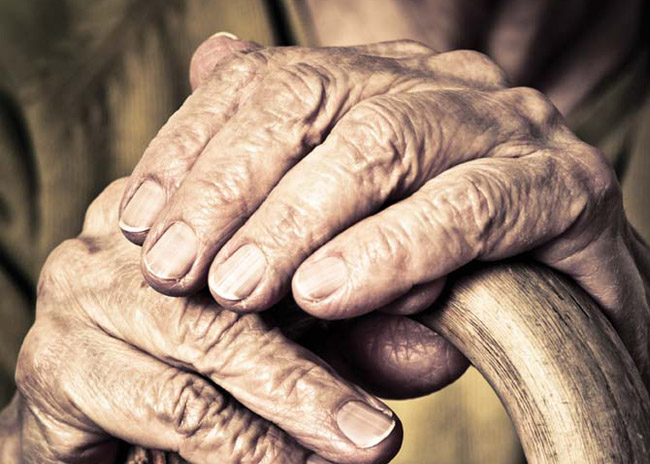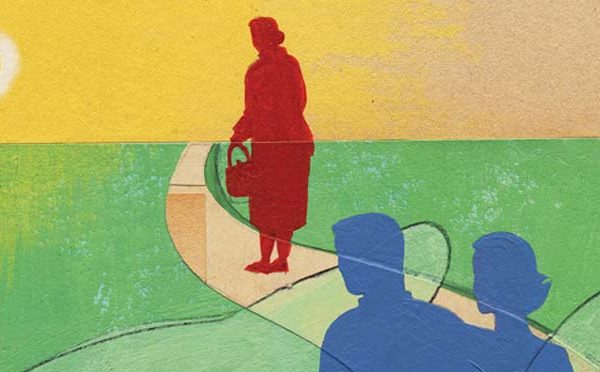The Frailty Factor
Little did Marilyn Kronsbein realize that her annual outdoor Christmas light decorating project in 2013 would land her in the Vanderbilt University Medical Center Trauma Department. A series of surgeries, plus months of follow-up and rehabilitation, have kept her from returning home for nearly two years.
Long-admired by her family for her self-sufficiency and strength in fighting a 50-year-long battle with rheumatoid arthritis, the then 75-year-old fell from a step ladder at her home on that late November day. With a broken leg bone protruding from her skin, she dragged herself over garden mulch, the shortest route to calling to her husband who was working inside.
“I don’t remember much of the pain, but I do remember seeing my leg and seeing my foot dangle when they put me in the ambulance,” said Kronsbein, now 77, who lives with her husband in an assisted living complex in Murfreesboro, Tennessee.
As a former trauma nurse, Assistant Professor Cathy Maxwell, PhD, RN, has seen first-hand the frequency and severity of injured elders in the Trauma Department. As a nurse researcher, she is advancing the field of geriatric trauma with a recent research study about frailty and a quality improvement project regarding palliative care consultations.
Prior studies show that frailty and cognitive decline predict poor outcomes of hospitalization after injury. But evidence-based knowledge about their influence on outcomes after hospitalization is lacking. Maxwell and her team hypothesized that pre-injury physical frailty and cognitive decline would predict functional decline and overall mortality in geriatric trauma patients at six months and one year after hospitalization. This research is yielding results that will provide pertinent information for individualized, goal-directed care. VUMC Trauma physicians, residents, nurse practitioners and nurses are already using this research to inform their older patients.
Geriatric Trauma
The prevalence of geriatric trauma is increasing in the United States as baby boomers reach age 65. According to the U.S. Census Bureau, the percentage of adults 65 and older will climb from 13.7 percent in 2013 to 21 percent in 2040.
“We clearly have seen a progressive increase in the number of geriatric patients that are being admitted to our trauma centers across the country,” said Richard Miller, MD, professor of Surgery and Chief of the Division of Trauma and Surgical Care, who partnered with Maxwell for this work. “Approximately 25 percent of trauma admissions across the country are from the geriatric population.”
Studies also show that the incidence and distribution of traumatic injury in older adults differ from young adults. Adults 65 and older are hospitalized for injury more than younger adults, even when the injury is less severe, and only 18 percent of older adults are discharged back to their home, or independent living, after a trauma injury.
“Older adults present differently than young, healthy trauma patients. Their ability to tolerate stress and survive is dependent on several factors, like comorbidities and pre-existing problems such as heart disease, diabetes and degenerative joint disease,” said Miller. “One-third of our patients have at least one or two of those problems which may be partly why they were injured in the first place. The No. 1 injury in older adults is falls, often related to their underlying diseases combined with being malnourished and dehydrated. Often these patients are living independently when they really should have assistance with activities of daily living.
Miller provides the example of occult hypo perfusion, which is elevated blood lactate levels without signs of shock. In a trauma setting, occult hypo perfusion illustrates the important nuances of care for older adults versus younger adults. Though the American Heart Association defines normal systolic blood pressure as under 120, Miller points out that older adults in trauma care may have a systolic blood pressure of 150 or 160, and that frequently when these older patients have a blood pressure of under 120, they may go into shock.
“It wasn’t unusual to see a patient come in for an injury, and we would get them stabilized. There would be a honeymoon period of a day or two and then the patient would crash, need a respirator or have a heart attack,” said Miller.
Maxwell approached Miller while she was a postdoctoral fellow at Vanderbilt School of Nursing. The two conducted an evaluation of geriatric patients in a prospective study. The interdisciplinary collaboration has continued since.
Research Focus
The Injured Older Adult Pre-injury Impairment study is a prospective cohort study with patients 65 and older admitted to Vanderbilt University Medical Center’s Level 1 Trauma Center between October 2013 and March 2014. Specifically, research assistants interviewed caregivers of 188 patients within 48 hours of hospital admission to determine pre-injury cognitive and physical frailty status using brief screening instruments. Variables such as demographics, injury severity and co-morbidities were obtained from the medical record. Follow-up phone calls were made at 30 days, 90 days, six months and one year to determine post-hospitalization status and outcomes.
“A comprehensive geriatric assessment provides an in-depth evaluation of frailty, but those take up to one hour to conduct,” said Maxwell. “I wanted a measure that could be conducted by bedside nurses and administered in a much shorter amount of time. I was interested in measures that could trigger further assessment and follow-up.”
The research team tested five different screening instruments—the AD8 Dementia screen, Informant Questionnaire on Cognitive Decline in the Elderly, Vulnerable Elder Survey, Barthel Index and Life Space Assessment. Each of the screens could be administered in less than five minutes.
“The physical frailty instruments differed in perspective, but all predicted mortality and decline,” said Maxwell.
According to prior research, frailty is defined as a condition of vulnerability characterized by inconsistency and instability after a stressor event. This is often the result of physiologic cumulative decline over a lifetime. Often frail older adults have reached a stage in which an external stressor of injury is a tipping point that initiates subsequent decline that can lead to death.
Studies show that dementia is present in up to one-third of hospitalized older adults, and delirium, or acute confusion, is reported in up to 37 percent of injured patients. Risk factors for delirium include pain, infection, sedative use, surgery, electrolyte disturbances, hypoxic events and nutritional deficiencies. The occurrence of delirium in injured older adults further complicates recovery. Interventions to prevent and treat delirium may include multiple components such as early mobilization, reducing sleep interruption, regular communication, contact with family, and provision of familiar objects.
Maxwell’s physical frailty assessment consisted of 38 questions and the cognitive impairment assessment consisted of 24 questions. It typically took 30 minutes to get informed consent and go through every one of the instruments. After discharge, Maxwell conducted 30-day, 90-day, six-month and one-year follow-up calls.
Challenges
“We identified potential patients through Vanderbilt’s Star Panel, which allows access to electronic clinical information in real time, to see who was coming into the trauma unit. A research assistant would go to the trauma unit every day and approach new patients—or their families—for enrollment. If we were able to get them enrolled and screened within 48 hours of admission, they were included in this study,” said Maxwell.
This geriatric population had unique challenges, such as finding primary surrogates (caregivers or family members) who could answer the questions on behalf of the patient. Delirium and dementia can make communications between the patient and health care provider difficult.
One hundred percent of the screens were conducted with primary surrogates, but only 41 percent were combined with a patient screen due to a multitude of reasons such as patients having cognitive impairment, being in pain or on pain medication or being sedated. And, sometimes patients wanted to participate in the study, but didn’t feel like answering the questions themselves. There were 27 patients who wished to be in the study, but had to be excluded because surrogates were not available (an inclusion criterion).
Initial Findings
Maxwell has mapped the initial functional trajectories. All three groups— frail, pre-frail and non-frail—declined 30 days after hospitalization. The non-frail group rebounded and often returned to their baseline before one year. The pre-frail group sometimes rebounded and returned to their baseline. The frail group did not return to baseline at all and 25 percent of these patients died within one year following hospitalization. “We are realizing that as most people age, they have not thought about how close they might be to the end of their life. Ninety percent of our patients were living in a home setting—a lot of them by themselves. Many fell or tripped over something in their home. Their injuries are typically viewed as fairly minor among trauma providers, however, the injury, among our frail patients, tipped them over into decline.”
The initial findings indicate that physical frailty is the primary predictor of decline and one-year mortality, even more so than age, comorbidities and injury severity.
“From what we saw in this study, we felt the next step needed to be aimed at getting palliative care to these patients, how to approach this, and how receptive patients and family caregivers would be to this,” said Maxwell.
Proactive Palliative Care
Armed with this information, Maxwell once again partnered with Richard Miller, as well as Mohana Karlekar, MD, medical director of VUMC Palliative Care, and Teresa Hobt-Bingham, MSN, RN, Trauma Patient Care Center Manager, for a quality improvement project titled “Geriatric Trauma and the Need for Proactive Palliative Care.”
The challenge: frailty is a primary predictor of poor outcome in older adults, however few hospitals screen for baseline frailty when a patient is admitted to a hospital. Furthermore, frailty is a poorly understood concept among both providers and the public. Frailty and dementia in older adults are not traditional triggers for palliative care consultations. In the VUMC Trauma Department, where the project was conducted, typically only 13 percent of the geriatric trauma patients received palliative care consultations during the 2011 to 2014 time frame.
The team wanted to determine if trauma nurses at the bedside could screen injured older adults (or their surrogates) for frailty and possible dementia; if screening for these impairments would trigger more palliative care consultations; and if screening and early palliative care consultation benefited providers, patients and families. They termed this “proactive” geriatric palliative care.
Consultations
Karlekar, assistant professor of Medicine, has a deep interest in how trauma and geriatric care intertwine. She defines palliative care as care of the seriously ill or injured and makes a point that it is not restricted to end-of-life care.
“Palliative care is a new specialty that cares for those seriously ill. This specialty focuses on three things: 1) Improving symptoms to help maximize quality of life; 2) Helping patients transition to hospice as appropriate; and 3) Helping establish ‘goals of care,’ a plan of care that is consistent with a patient’s wishes and is medically possible,” said Karlekar. “In our geriatric trauma patients, we want to facilitate a better understanding of frailty, as well as associated issues that may arise going forward so that patients and families are better informed and prepared for future potential medical complications.”

Interdisciplinary collaboration among all involved was crucial to this research. Team members include: (front row) Mohana Karlekar, MD, Cathy Maxwell, PhD, and Richard Miller, MD, (back row) Teresa Hobt-Bingham and Ryan Vance, RN. Photo by Susan Urmy.
The VUMC Palliative Care team consists of six physicians and two nurse practitioners, each of whom provide consultations.
“An admission to the trauma ICU is a wake-up call, a harbinger that bad things may happen,” said Karlekar. “We frequently see older adults in trauma care for falls. If a healthy 40-year-old falls, they don’t end up in the trauma unit.
“We on the palliative care team prefer to get involved in the process early so that ideally we can talk with patients to better understand how they define their quality of life. Our goal is not to change any immediate decision making, but rather give patients and their families an idea of what the major clinical trajectories may look like which will hopefully allow them to make better decisions for themselves. Our hope is that patients will be better informed and not have to make complex end-of-life decisions in crisis,” she said.
As part of the palliative care consultations in the VUMC Trauma Unit, the initial findings from the frailty and cognitive impairment study are already put into practice. They are important message points shared with patients and their families.
Nurse Buy-In
Bedside nurses in the Vanderbilt Trauma Unit played a crucial role in this study, according to Karlekar, Miller and Maxwell.
“A lot of trauma patients in general have devastating injuries that are really going to affect their quality of life from here on out,” said Hobt-Bingham. “Cathy had already conducted her study on this. Her next step was to see if our nurses were willing to do the bedside screenings.”
“I knew our Trauma Department Nurse Unit Board would agree to do this, provide positive reinforcement and get their peers excited and involved,” said Hobt-Bingham. “We role-played the questions and answers at the unit board meeting and staff meetings. At no more than 90 seconds, it was so fast and easy.”
In addition to the questions, the nursing team worked on framing the narrative of how to approach the palliative care conversation, which can be difficult. “We used scripting, such as: ‘Mrs. Smith, I would like to ask you some questions as it will help us plan for your mother’s care,’” said Hobt-Bingham.
“The approach of nurse-empowered interventions really transcends,” said Karlekar. “The nurse identifies the trigger. The doctor initiates the referral, and the palliative care doctor or nurse practitioner closes the loop.”
Among 70 patients who were screened by bedside nurses, 23 percent screened positive for both frailty and possible dementia. Project leaders met with physicians and trauma staff through the project for feedback and suggestions for improvement at regular intervals. Charge nurses rounded on older patients on a daily basis to prompt bedside nurse screening. Medical receptionists distributed and collected screening instruments each day.
During this project, 36 percent of patients screened positive for frailty and 34 percent for pre-frailty. Thirty-four percent screened positive for possible dementia. Palliative care consultations increased to 32 percent.
Even though the project has concluded, bedside nurses opted to continue screening older patients while Maxwell tracks admissions, screenings, and percentage of palliative care consultations.
“I have continued to round on the Trauma Unit and follow the nurse screening that still continues,” said Maxwell. “I see how everyone’s role contributes to the overall success of this project. For instance, the six medical receptionists are very engaged in this work. In many cases, they prompt the bedside nurses to screen and the receptionists help streamline the process so that forms are not lost or misplaced.”
Next Steps
The project leaders for both studies are preparing various manuscripts and presentations to share more of the findings with peer organizations. Maxwell recently presented at the American Association for the Surgery of Trauma (AAST) and Karlekar will lead an interdisciplinary presentation at the American Academy of Hospice and Palliative Medicine in March 2016.
Maxwell is already pursuing a new grant regarding early geriatric palliative care for injured older adults to explore patient, caregiver and provider perceptions and preferences, quantify outcomes of proactive geriatric palliative care, and examine receptivity to this innovative approach.
“I want Vanderbilt to be the epicenter of this plan of action on the long-term outcome of geriatric trauma patients,” said Miller. “We have enough powerful data to show that we will make a huge difference in the way we manage geriatric trauma patients across the country.”









